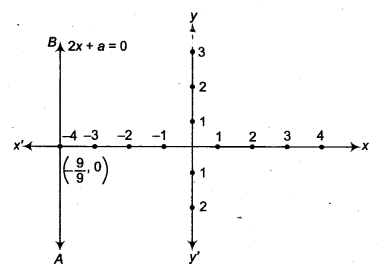Question 1.
The cost of a notebook is twice the cost of a pen. Write a linear equation in two variables to represent this statement.
(Take the cost of a notebook to be ₹ x and that of a pen to be ₹ y)
Solution:
Let the cost of a notebook = ₹ x
and the cost of a pen = ₹ y
According to question,
Cost of a notebook = 2(cost of a pen)
∴ x = 2y
⇒ x- 2y = 0
Question 2.
Express the following linear equations in the form ax + by + c = 0 and indicate the values of a, b and c in each case.
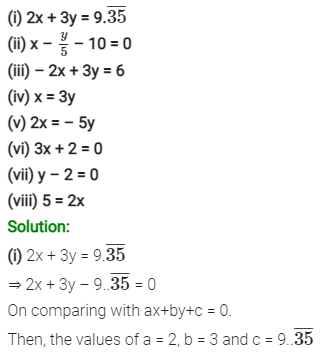

(iii) – 2x+ 3y = 6
⇒ -2x + 3y – 6=0
On comparing with ax + by + c = 0, then the values of a = – 2, b = 3 and c = – 6
(iv) x = 3y ⇒ x-3y+0=0
On comparing with ax + by + c = 0, then the values of a = 1, b = – 3 and c = 0.
(v) 2x = -5y
⇒ 2x + 5y + 0=0
On comparing with ax + by + c = 0, then the values of a = 2, b = 5 and c = 0.
(vi) 3x + 2 = 0
⇒ 3x + 0y + 2 = 0
On comparing with ax + by + c = 0, then the values of a = 3, b = 0 and , c= 2.
(vii) y – 2 = 0
⇒0x+y-2 = 0
On comparing with ax + by + c = 0, then the values of a = 0, b = 1 and c = – 2.
(viii) 5 = 2x ⇒ 2x + 0y – 5 = 0
On comparing with ax + by + c = 0, then the values of a = 2, b = 0 and c = – 5.
Question 1.
Which one of the following options is true and why? y = 3x + 5 has
- (i) a unique solution
- (ii) only two solutions
- (iii) infinitely many solutions
Solution:
(iii) A linear equation in two variables has infinitely many solutions.
Question 2.
Write four solutions for each of the following equations
- (i) 2x + y = 7
- (ii) πx + y = 9
- (iii) x = 4y
Solution:
(i) 2x + y = 7
By inspection, x = 2 and y = 3 is a solution because for x = 2, y = 3,
2x + y = 2 x 2 + 3 = 4 + 3 = 7
Now, let us choose x = 0 with this value of x, the given equation reduces to y = 7.
So, x = 0, y = 7 is also a solution of 2x + y = 7. Similarly, taking y = 0,
the given equation reduces to 2x = 7 which has the unique solution x = 7/2.
So, x = 7/2, y = 0 is a solution of 2x + y = 7.
Finally, let us take x = 1
The given equation now reduces to 2 + y = 7 hose solution is given by y = 5.
Therefore, (1, 5) is also a solution of the given equation.
So, four of the infinitely many solutions of the given equation are (2, 3), (0, 7), ( 7/2 , 0) and (1,5).
(ii) πx + y = 9

Now, let us choose x = 0 with this value of x,
the given equation reduces to y = 9 which has a unique solution y = 9.
So, x = 0, y = 9 is also a solution of πx + y = 9
Similarly, taking y = 0, the given equation reduces to x = 9/π So, x = 9/π ,y = 0 is a solution of πx + y = 9as well.
Finally, let us take x = 7 the given equation now reduces to 22/7 . 7 + y = 9
whose solution is given by y = -13.
Therefore; (7,-13) is also a solution of the given equation.
So, four of the infinitely many solutions of the given equation are

(iii) x = 4y ⇒ x - 4y = 0
By inspection, x = 0, y = 0 is a solution because for x = y = 0, 0 - 4 x 0 = 0 - 0 = 0, it satisfies.
Now, let us choose x = 4 with this value of x,
the given equation reduces to y = 1 which has a unique solution y = 1.
So, x = 4, y = 1 is also a solution , of x - 4y = 0. Similarly, taking y = 1/2 , the given equation reduces to x = 2.
So , x = 2, y = 1/2 is a solution x - 4y = 0 as well.
Finally, let us take x = 1, the given equation now reduces to 1 - 4y = 0
whose solution is given by y = 1/4. Therefore, (1,1/4) is also a solution of the given equation. So, four
of the infinitely many solutions of the given equation are

Question 3.
Check which of the following are solution of the equation x – 2y = 4 and which are not?
- (i) (0, 2)
- (ii) (2,0)
- (iii) (4,0)
- (iv) (√2,4√2)
- (v) (1,1)
Solution:
(i) Take x – 2y and put x = 0, y = 2,
we get 0 - 2 x 2 = 0 - 4 = -4 ≠ 4
Hence, (0, 2) is not a solution of x - 2y = 4.
(ii) Take x - 2y and put x = 2, y = 0,
we get 2 - 2 x 0 = 2 - 0 = 2 ≠ 4
Hence, (2, 0) is not a solution of x - 2y = 4.
(iii) Take x - 2y and put x = 4, y = 0;
we get 4 - 2 x 0 = 4 - 0 = 4
Hence, (4, 0) is a solution of x - 2y = 4.
(iv) Take x - 2y and put x = √2, y = 4√2, we get
√2 - 2 x 4√2 = √2 - 8√2 =-7√2 ≠ 4
Hence, (√2,4√2) is not a solution of x - 2y = 4
(v) Take x - 2y and put x = 1, y = 1,
we get 1 - 2 x 1 = 1 - 2 = -1 ≠ 4
Hence, (1,1) is not a solution of x - 2y = 4.
Question 4.
Find the value of k, if x = 2, y = 1 is a solution of the equation 2x + 3 y = k.
Solution:
Take 2x + 3y = k
Put x = 2, y = 1 then we get, 2 x 2 + 3 x 1 = k
⇒ 4 + 3 = k
⇒ k = 7
Question 1.
Draw the graph of each of the following linear equations in two variables
- (i) x + y = 4
- (ii) x – y = 2
- (iii) y = 3x
- (iv) 3 = 2x + y
Solution:
(i) x + y = 4
To draw the graph, we need atleast two solutions of the

So, draw the graph by plotting the two points from table and then joining by a line.
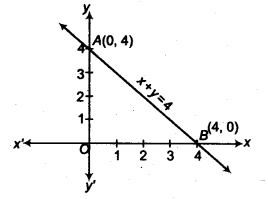
(ii) x - y = 2
To draw the graph, we need atleast two solutions of the equation.

So, draw the graph by plotting the two points from table and then joining by a line.
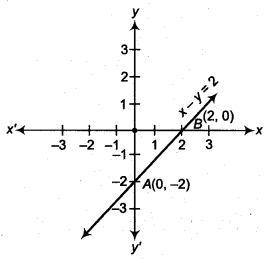
(iii) y = 3x
To draw the graph, we need atleast two solutions of the equation.

So, draw the graph by plotting the two points from table and then by
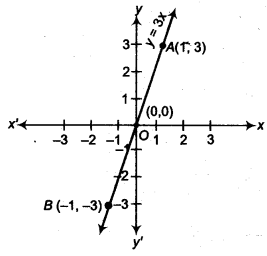
(iv) 3 = 2x + y
To draw the graph, we need atleast two solutions of the equation.

So, draw the graph by plotting the points from the table and the by joining the same by a line.
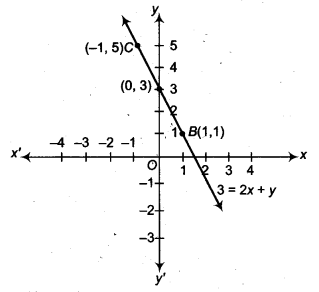
Question 2.
Give the equations of two lines passing through (2,14). How many more such lines are there, and why?
Solution:
Here, (2,14) is a solution of a linear equation. One example of such a linear equation is y = 7x, others are x + y- 16.
There are infinitely many lines because there are infinitely many linear equations which are satisfied by the. coordinates of the point (2,14).
Question 3.
If the point (3,4) lies on the graph of the equation 3y – ax – 7, find the value of a.
Solution:
If the point (3, 4) lies on the graph, then it will satisfies the equations.
Hence, 3 (4) – a (3) – 7 = 0
⇒ 12 – 3a – 7 = 0
⇒ 5 – 3a = 0
⇒ 3a = 5
⇒ a = 5/3
Question 4.
The taxi fare in a city is as follows :
For the first kilometre, the fare is ₹ 8 and for the subsequent distance it is ₹5 per km. Taking the distance covered as x km and the total fare as ₹y, write a linear equation for this information and draw its graph.
Solution:
Distance covered = x km = 1+ (x – 1) km
Fare for first kilometre = ₹ 8
Fare for next (x-1 ) km = (x – 1) x 5 = 5(x-1)
According to question, total fare = y
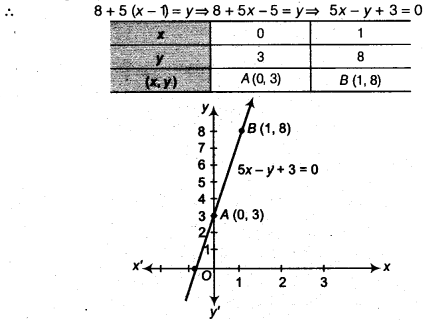
Now, plot the points A (0,3) and B (1, 8) on a graph paper and joining them, to form q line AB.
Question 5.
From the choices given below, choose the equation whose graphs are given in Fig. (a) and Fig. (b).
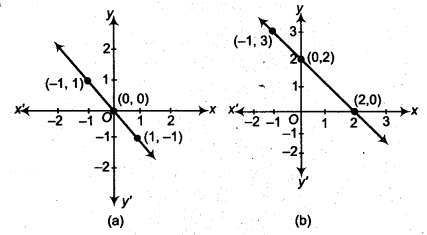
- For Fig. (a)
- (i) y = x
- (ii) x + y = 0
- (iii) y = 2x
- (iv) 2 + 3y = 7x
- For Fig. (b)
- (i) y = x + 2
- (ii) y = x – 2
- (iii) y = – x + 2
- (iv) x + 2y = 6
Solution:
In Fig. (a), we observe that the points (-1,1) and (1,-1) passes through the equation x + y = 0
∵ At (-1,1) x + y = -1 + 1 = 0
and at (1, -1) x + y = 1 -1 = 0
In Fig. (b), we observe that the points (-1, 3), (0, 2) and (2, 0) passes through the equation x + y = 2.
∵ At (-1,3), x + y = -1 + (3) = + 2
At ( 0 , 2 ) , x +y = 0+2 = 2
and at ( 2, 0 ) x+ y = 2 + 0= 2
Question 6.
If the work done by a body on application of a constant force is directly proportional to the distance travelled by the body, express this in the form of an equation in two variables and draw the graph of the same by taking the constant force as 5 units. Also, read from the graph the work done when the distance travelled by the body is.
(i) 2 units
(ii) 0 unit.
Solution:
Given: that, work done by a body on application of a constant force is directly proportional to the distance travelled by the body.
i.e., (W) work done ∝ distance (s)
⇒ W = F. s
(Where, F = arbitrary constant which take the value 5 units)
∴ W = 5s …(i)

Now, plot the points O (0,0), A (1,5) and B (2,10) on graph paper and joining them to get a line AB.
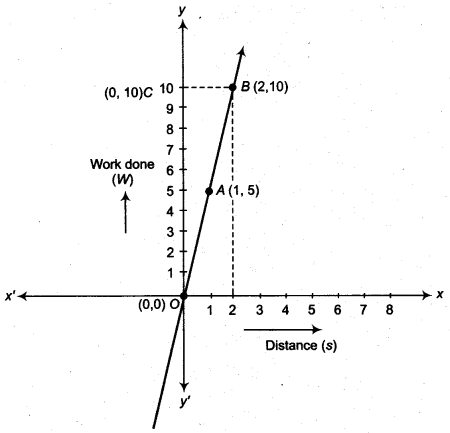
(i) From point B (2,10), draw a line parallel to OY to intersect the x-axis at (2,0) and draw a line parallel to x-axis intersect at C (0, 10).
∴ Work done when the distance travelled by the body is 2 units = 10units.
(ii) Clearly y = 0 when x = 0 so the work done when the distance travelled by the body is 0 unit.
Question 7.
Yamini and Fatima, two students of class IX of a school, together contributed ₹100 towards the Prime Minister’s Relief Fund to help the earthquake victims. Write a linear equation which satisfies this data. (You may take their contributions as ₹ x and ₹ y.) Draw the graph of the same.
Solution:
Let the contributions of Yamini and Fatima together towards the Prime Minister’s Relief Fund to help the earthquake victims are ₹x and ₹y, respectively.
Then, by given condition,

Here, we plot the points B (0,100) and A (100, 0) on graph paper and join all these points to form a line AB.
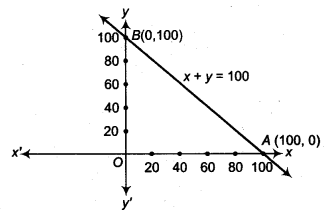
Question 8.
In countries like USA and Canada, temperature is measured in Fahrenheit, whereas in countries like India, it is measured in Celsius. Here is a linear equation that converts Fahrenheit to Celsius.
F = (9/5) c + 32
- (i) Draw the graph of the linear equation above using Celsius for x-axis and Fahrenheit for y-axis.
- (ii) If the temperature is 30 °C, what is the temperature in Fahrenheit?
- (iii) If the temperature is 95°F, what is the temperature in Celsius?
- (iv) If the temperature is 0°C, what is the temperature in Fahrenheit and if the temperature is 0°F, what is the temperature in Celsius?
- (v) Is there a temperature which is numerically the same in both Fahrenheit and Celsius? If yes, find it.
Solution:
(i) Given, linear equation in Fahrenheit and Celsius is
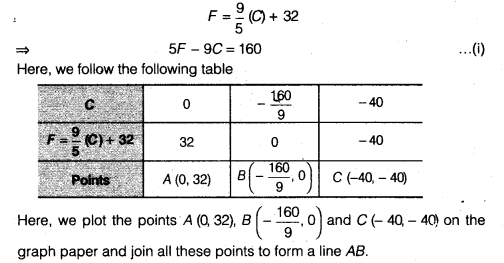
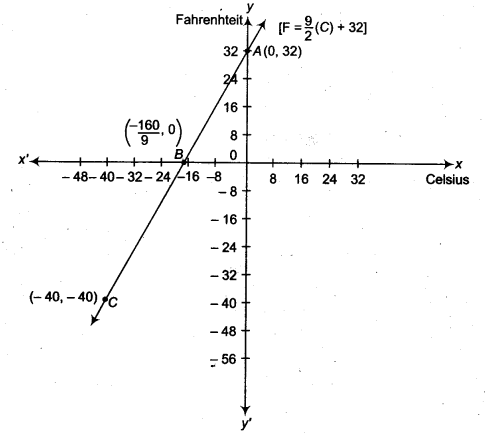
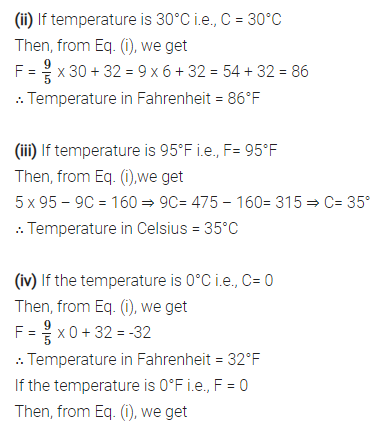

Question 1.
Give the geometric representations of y = 3 as an equation
- (i) in one variable.
- (ii) in two variables.
Solution:
The given linear equation is
y=3 …(i)
(i) The representation of the solution on the number line is shown in the figure below, where y = 3 is treated as an equation in one variable.

(ii) We know that, y = 3 can be written as
0 . x + y = 3
which is a linear equation in the variables x and y. This is represented by a line. Now, all the values of x are permissible because 0 . x is always 0.
However, y must satisfy the equation y = 3.
Note that, the graph AB is a line parallel to the x-axis and at a distance of 3 units to the upper side of it.
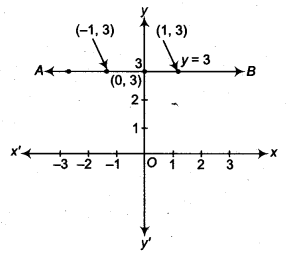
Question 2.
Give the geometric representations of 2x + 9 = 0 as an equation
- (i) in one variable.
- (ii) in two variables.
Solution:
The given linear equation is
2x + 9=0
⇒ x = - 9/2 .. ( i)
(i) The representation of the solution on the number line is shown in the figure below, where x = - 9/2 is treated as an equation in one variable.

(ii) We know that, 2x + 9= 0 can be written as
2x + 0y + 9 = 0
which is a linear equation in two variables x and y.
This is represented by a line.
Now, all the values of y are permissible because 0 .
y is always 0.
However, x must satisfy the equation 2x + 9 = 0.
Note that, the graph AB is a line parallel to the y-axis and at a distance of - 9/2= - 4.5 to the left of it.
